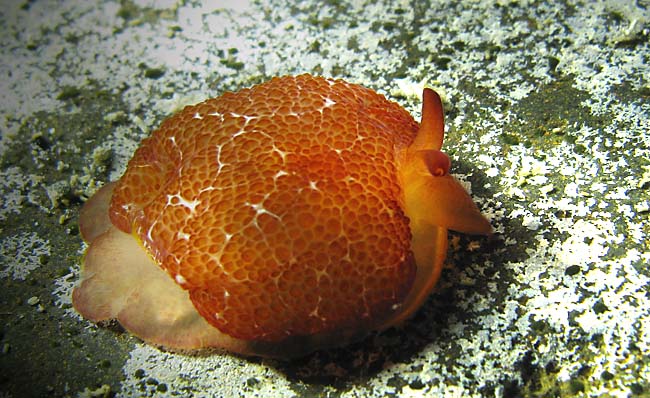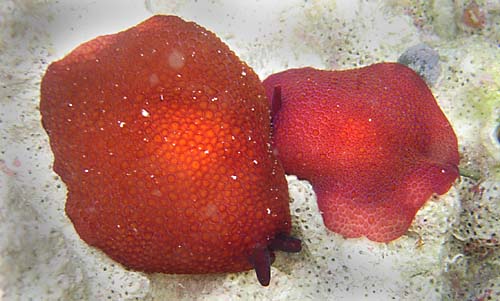This species has been observed on Reunion, Mauritius and Mayotte Islands
Species characteristics : The mantle is covered in small tubercles each outlined by a polygon which is either deeper in colour than the background colour, or sometimes white. |

|
|
| Showing species characteristics... | Photo Philibert Bidgrain |
|
See more about : Sightening and mating periods
See more about : Pleurobranchus peronii variability in Reunion island
An abnormal specimen of Pleurobranchus peronii ?
Remarks :
Identification confirmed by Bill Rudman and Nathalie Yonow
Synonymous : (according Worms)
- Oscaniella purpurea Bergh, 1897 - Pleurobranchus ovalis Pease, 1868
- Pleurobranchus cornutus Quoy & Gaimard, 1832 - Pleurobranchus papillatus Risbec, 1951
- Pleurobranchus giardi Vayssière, 1896 - Pleurobranchus winckworthi White, 1946
- Pleurobranchus hirasei Baba, 1971 - Pleurobranchus xhosa Macnae, 1962
- Pleurobranchus inhacae Macnae, 1962
Bibliographic data :
It is known in some places as the polygon slug because of the way the edge of the tubercles are often outlined in a darker colour to give a pattern of polygons over the back.
The species is quite variable in colour, and individuals change colour during their lifetime. As the animal grows, all the tubercules gradually colour, from the tip down, and the purple fades from the scattered purple-tipped tubercles
The tentacles are formed from the rolling of the tissue into an open tube.
Juvenile specimens are usually distinctly different in colour with a translucent white background, some of the tubercles tipped with reddish purple and the mantle edged in orange or red. The juvenile colour form is similar to the juvenile form of P. grandis and P. forskalii but they can be distinguished by the absence of the white reticulate pattern in P. peronii.
The internal shell in this species is transparent and only thinly calcified. It usually stops growing oonce it reaches about 7 or 8 mm in length, and in animals larger than about 6 cm it is often absent.
There is a long , oval, pale area present on the undersurface (pedal or metapodial gland) of the tail in sexually mature specimens.
The foot matches the mantle colouration but is consistently paler and is unspotted
It lays a white spirally-arranged egg mass with one edge atached to the substrate and the other very wavy
It feeds on the compound ascidian Ritterella sp
It could be confuse with P. albiguttatus but in P.albiguttatus the foot is spoted with orange or brown
References :
Bill Rudman Seaslug site : Sea Slug Forum : Pleurobranchus peroni
Nudipixel Pleurobranchus peroni
Publications :
Cuvier, G.L. (1804). Mémoire sur la Phyllidie et sur le Pleurobranche, deux nouveaux genres de mollusques de l'ordre des gastéropodes, et voisins des patelles et des oscabrions, dont l'un est nu dont l'autre porte une coquille cachée. Annales du Muséum National d'Histoire Naturelle, Paris, 5 : 266-276.
Goodheart J., Camacho-García Y., Padula V., Schrödl M., Cervera J.L., Gosliner T.M. & Valdés Á. (2015). Systematics and biogeography of Pleurobranchus Cuvier, 1804, sea slugs (Heterobranchia: Nudipleura: Pleurobranchidae). Zoological Journal of the Linnean Society. 174: 322-362.,
Other photos of Pleurobranchus peronii :
 |
Maurice Jay Reunion, "Cap la Houssaye" at Saint Paul, size : 10 mm. Juvenile specimens are usually distinctly different in colour with a translucent white background, some of the tubercles tipped with reddish purple and the mantle edged in orange or red. In this specimen the rhinophores are tipped with orange and red.
|
Christophe Cadet Reunion, Etang salé on a Rocky coast, less 1 m, 28 August 2010, size : 18 mm In this juvenile specimen, we can see the first traces ( a) of the adult pattern ... |
 |
Reunion, Etang salé on the rocky coast, less 1 m, 9 November 2006. |
Philibert Bidgrain |
 |
Two specimen found under a dead coral with a spawn characteristic of this species : a white spirally-arranged egg mass with one edge atached to the substrate and the other very wavy
|
Hugues Flodrops Reunion, Etang salé on a Rocky coast, less 1 m, 19 October 2007, size : 40 mm. The mantle is covered in small tubercles each outlined by a polygon which is either deeper in colour than the background colour. In this specimen some polygon are deeper colored... |
 |

Coquille en forme de feuille, au sommet arrondi et ourlé, creuse. Face convexe papyracée brune avec des stries concentriques serrées. Face concave calcaire blanchâtre. Longueur maximale animal 12 mm. Coquille 5,5 mm. |
Maurice Jay, Reunion, |
|
Maurice Jay Reunion, The background is red, and white mottling is developed. In this specimen some polygon are deeper colored... |  |
 |
Christophe Cadet Reunion, Etang salé on a Rocky coast, less 1 m, 20 September 2009, size : 55 mm . |
Hugues Flodrops Reunion, Etang salé on the rocky coast, less 1 m, 9 March 2008, size : 30 mm. This specimen looks like some specimen of P. forskalii The mantle is covered in small tubercles each outlined by a polygon which is either deeper in colour than the background colour, or sometimes white.
|
 |
 |
Philibert Bidgrain Reunion, Etang salé on the rocky coast, less 1 m, 25 September 2009, size : 45 mm. A red form with some white spots speckling all over the mantle |
Kevin Bourdon Reunion, Cap la Houssaye, 10 m, 4 October 2013, size : 4-5 mm
A juvenil form. Medium or large oblong-shaped slugs which have two well developed cylindrical rhinophores on the head and two oral tentacles attached to either side of an oral veil. |
 |
More photos from Indian Ocean
See more about : Pleurobranchus peronii variability in Reunion island
An abnormal specimen of Pleurobranchus peronii ?
Reunion, head detail of P. peronii, at Etang salé, by Christophe Cadet
Reunion, orange form of Pleurobranchus peronii, at Etang salé, by Hugues Flodrops
Reunion, juvenile form of Pleurobranchus peronii, at Saint Paul, by Sully Bachel
Mayotte, red form of Pleurobranchus peronii, at mboueanatsa, by Philibert Bidgrain
Mayotte, red form of Pleurobranchus peronii, by Sylvain Le Bris
Reunion, orange Pleurobranchus peronii, at Etang salé, by Christophe Cadet
Reunion, two red specimens of Pleurobranchus peronii, at Etang salé, by Christophe Cadet
Reunion, Pleurobranchus grandis or peronii, at Etang salé, by Philibert Bidgrain
Mayotte, orange form of Pleurobrachus peronii, by Emmanuelle Aigle
Mauritius, a large specimen of Pleurobranchus peronii, at Mahebourg, by Yann von Arnim


